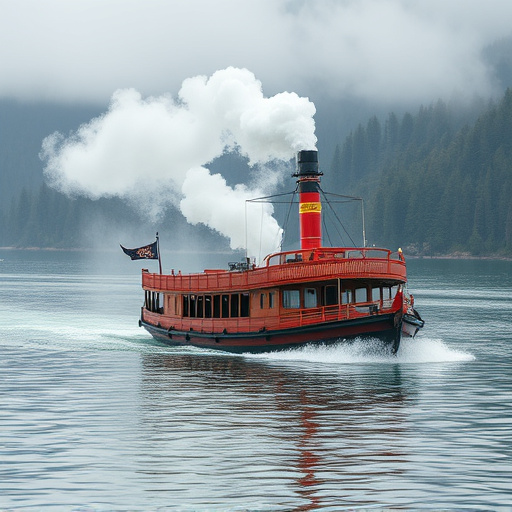In the 19th century, Steam Boats revolutionized maritime transport with their steam-powered engines, enabling faster and longer journeys for both commercial shipping and passenger travel. Utilizing high-pressure steam from boiled water in a boiler, these vessels powered propellers or paddles via cylinders connected to a crankshaft. The Steam Boat's unique propulsion system and historical charm make it an eco-friendly, versatile transport solution suitable for diverse water bodies, leisure cruises, and explorative adventures, offering unparalleled advantages for long journeys with its sturdy construction and powerful engines.
A steam boat, powered by steam engines, is a unique watercraft that has shaped maritime history. It offers a smooth and efficient journey, making it ideal for both leisure and commercial purposes. This article delves into the world of steam boats, exploring their functionality, target users, and suitability for extended voyages. Discover how these vessels, once dominant in transportation, continue to capture imaginations with their classic charm and reliable performance. Uncover the allure of a steam boat ride, perfect for those seeking an authentic, historical experience on water.
- What is a Steam Boat?
- How Does a Steam Boat Work?
- Who Should Use a Steam Boat?
- Are Steam Boats Suitable for Long Journeys?
What is a Steam Boat?

A steam boat, also known as a steamship, is a watercraft that uses steam power to generate propulsion. Unlike traditional boats that rely on sails or motors, steam boats harness the power of steam to drive their engines, making them unique in their historical and technological significance. This ancient mode of transportation played a pivotal role in revolutionizing maritime travel during the 19th century.
These vessels operate by utilizing high-pressure steam produced from boiling water in a boiler. The steam is then directed into cylinders connected to a propeller or paddles, which turns the boat’s wheels or blades, propelling it forward through the water. The efficiency and power of steam engines allowed for faster and longer journeys, making steam boats ideal for both commercial shipping and passenger travel.
How Does a Steam Boat Work?

A steam boat, as the name suggests, is a watercraft that uses steam power to generate movement, unlike traditional boats that rely on motors or sails. Its primary source of propulsion is a steam engine, which converts heat energy from burning fuel (like coal or wood) into mechanical energy through a series of intricate processes. The engine drives a propeller, allowing the vessel to navigate through water. This unique method of transportation has been a significant innovation in maritime history.
The operation involves several key components: a boiler for generating steam, a cylinder and piston mechanism to convert the steam’s pressure into linear motion, and a propeller to provide forward thrust. As steam is released under pressure, it enters the cylinder, pushing the piston, which in turn rotates the crankshaft connected to the propeller. This process enables the boat to glide smoothly across bodies of water, making it suitable for various applications.
Who Should Use a Steam Boat?

A steam boat is an innovative watercraft that harnesses the power of steam to generate propulsion, offering a unique and historic mode of transportation. It’s a versatile vessel suitable for various purposes and water bodies, from serene lakes to mighty rivers and coastal waters.
Ideal candidates for using a steam boat include history enthusiasts who appreciate the charm of vintage technology, eco-conscious travelers seeking alternative modes of transport, and adventure seekers exploring remote areas with limited infrastructure. Its ability to navigate different terrains and its relatively quiet operation make it suitable for both leisure cruises and explorative journeys. For long-distance travel, the steam boat’s stability and passenger comfort are significant advantages, ensuring a smoother experience compared to some faster motorboats.
Are Steam Boats Suitable for Long Journeys?

Steam boats, with their iconic smoke stacks and hissing engines, have a rich history as a mode of transportation on water. Despite advancements in technology, they still hold their charm for many enthusiasts. When it comes to suitability for long journeys, steam boats have distinct advantages. Their robust construction and powerful engines enable them to navigate through various water conditions, making them ideal for extensive voyages.
The longevity of steam boats is a significant factor for long-distance travel. Unlike modern vessels that might prioritize speed, these classic boats offer a more leisurely pace, allowing passengers to enjoy the journey. Moreover, their ability to generate steam provides consistent power, ensuring they can maintain a steady course even in challenging weather conditions. This makes them an excellent choice for those seeking a unique and memorable adventure on open waters.
A steam boat represents a unique and efficient mode of transportation, offering both comfort and history. For those seeking a different travel experience, particularly on longer journeys, a steam boat can provide an unparalleled adventure. Its functionality and appeal lie in the seamless fusion of traditional engineering and modern comfort, making it accessible to a wide range of users from history enthusiasts to leisure travelers. While not always the fastest option, the charm and reliability of steam boats make them ideal for exploring distant destinations at a steady pace, ensuring a memorable journey every step of the way.
